1037–1063 Toghrul I (first) Founded 1037 Date dissolved 1194 | Government Monarchy Area 3.9 million km² | |
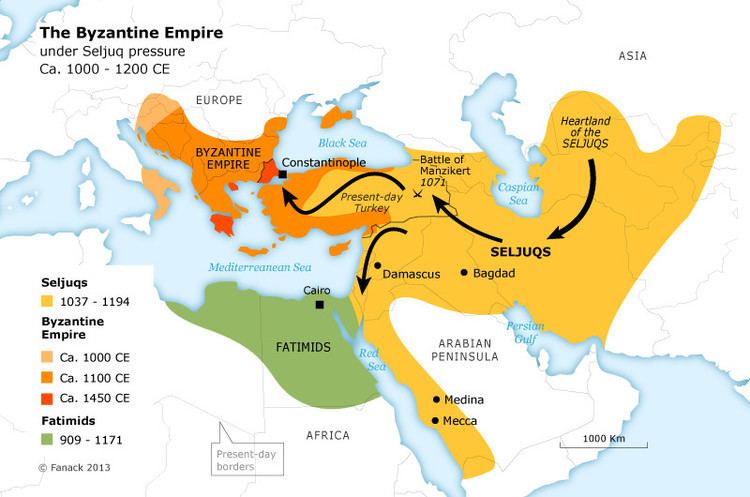 | ||
Capital Nishapur(1037–1043)Rey(1043–1051)Isfahan(1051–1118)Hamadan, Western capital (1118–1194)Merv, Eastern capital (1118–1153) Languages Persian (official & court language; lingua franca;)Oghuz Turkish (dynastic and military)Arabic (Language of law, theology and science)) Similar Abbasid Caliphate, Ottoman Empire, Fatimid Caliphate | ||
The rise and fall of the seljuk empire
The Seljuk Empire or Great Seljuk Empire (also spelled Seljuq) (Persian: آل سلجوق) was a medieval Turko-Persian Sunni Muslim empire, originating from the Qynyq branch of Oghuz Turks. The Seljuk Empire controlled a vast area stretching from the Hindu Kush to eastern Anatolia and from Central Asia to the Persian Gulf. From their homelands near the Aral Sea, the Seljuks advanced first into Khorasan and then into mainland Persia before eventually conquering eastern Anatolia.
Contents
- The rise and fall of the seljuk empire
- The great seljuk empire
- Founder of the Dynasty
- Expansion of the Empire
- Tughril and Chaghri
- Alp Arslan
- Malik Shah I
- Governance
- Division of empire
- First Crusade
- Second Crusade
- Decline
- Conquest by Khwarezm and the Ayyubids
- Legacy
- References
The Seljuk empire was founded by Tughril Beg (1016–63) in 1037. Tughril was raised by his grandfather, Seljuk-Beg, who was in a high position in the Oghuz Yabgu State. Seljuk gave his name to both the Seljuk empire and the Seljuk dynasty. The Seljuks united the fractured political scene of the eastern Islamic world and played a key role in the first and second crusades. Highly Persianized in culture and language, the Seljuks also played an important role in the development of the Turko-Persian tradition, even exporting Persian culture to Anatolia. The settlement of Turkic tribes in the northwestern peripheral parts of the empire, for the strategic military purpose of fending off invasions from neighboring states, led to the progressive Turkicization of those areas.
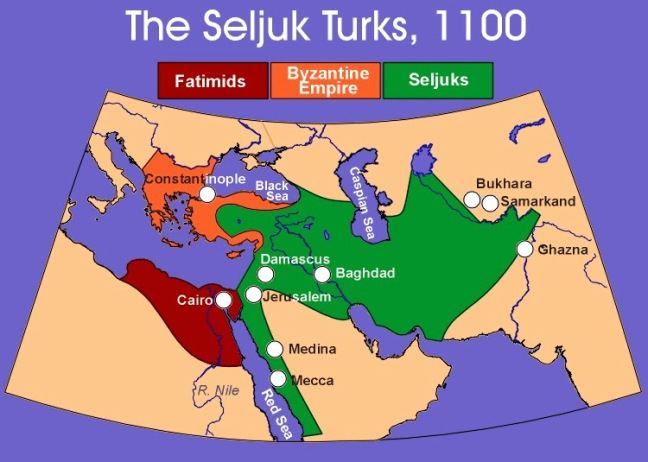
The great seljuk empire
Founder of the Dynasty
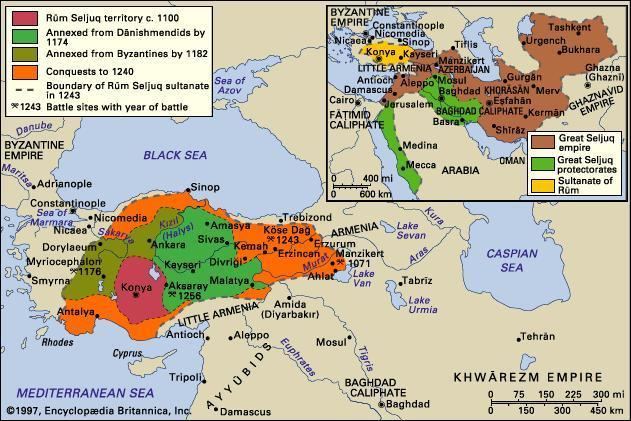
The apical ancestor of the Seljuqs was their beg, Seljuk, who was reputed to have served in the Khazar army, under whom, circa 950, they migrated to Khwarezm, near the city of Jend, where they converted to Islam.
Expansion of the Empire

The Seljuqs were allied with the Persian Samanid shahs against the Qarakhanids. The Samanid fell to the Qarakhanids in Transoxania (992–999), however, whereafter the Ghaznavids arose. The Seljuqs became involved in this power struggle in the region before establishing their own independent base.
Tughril and Chaghri
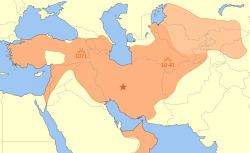
Tughril was the grandson of Seljuq and brother of Chaghri, under whom the Seljuks wrested an empire from the Ghaznavids. Initially the Seljuqs were repulsed by Mahmud and retired to Khwarezm, but Tughril and Chaghri led them to capture Merv and Nishapur (1037). Later they repeatedly raided and traded territory with his successors across Khorasan and Balkh and even sacked Ghazni in 1037. In 1040 at the Battle of Dandanaqan, they decisively defeated Mas'ud I of the Ghaznavids, forcing him to abandon most of his western territories to the Seljuqs. In 1055, Tughril captured Baghdad from the Shi'a Buyids under a commission from the Abbasids.
Alp Arslan
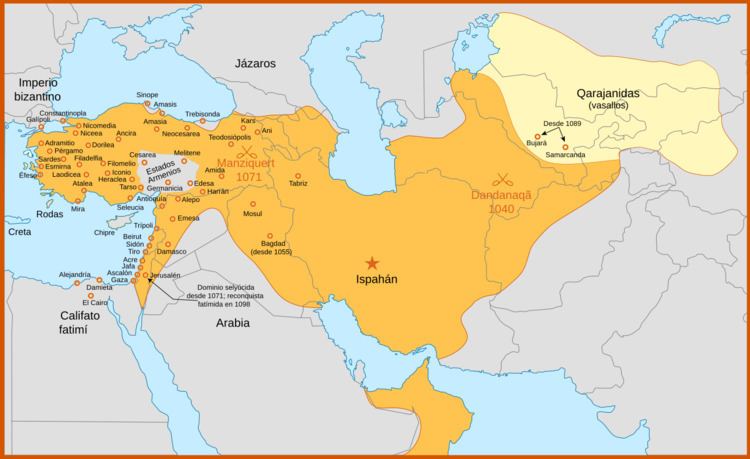
Alp Arslan, the son of Chaghri Beg, expanded significantly upon Tughril's holdings by adding Armenia and Georgia in 1064 and invading the Byzantine Empire in 1068, from which he annexed almost all of Anatolia. Arslan's decisive victory at the battle of Manzikert in 1071 effectively neutralized the Byzantine resistance to the Turkish invasion of Anatolia. He authorized his Turkmen generals to carve their own principalities out of formerly Byzantine Anatolia, as atabegs loyal to him. Within two years the Turkmens had established control as far as the Aegean Sea under numerous beghliks (modern Turkish beyliks): the Saltukids in Northeastern Anatolia, the Shah-Armens and the Mengujekids in Eastern Anatolia, Artuqids in Southeastern Anatolia, Danishmendis in Central Anatolia, Rum Seljuqs (Beghlik of Suleyman, which later moved to Central Anatolia) in Western Anatolia, and the Beylik of Tzachas of Smyrna in İzmir (Smyrna).
Malik Shah I
Under Alp Arslan's successor, Malik Shah, and his two Persian viziers, Nizām al-Mulk and Tāj al-Mulk, the Seljuq state expanded in various directions, to the former Iranian border of the days before the Arab invasion, so that it soon bordered China in the east and the Byzantines in the west. Malikshāh moved the capital from Rey to Isfahan and it was during his reign that the Great Seljuk Empire reached its zenith. The Iqta military system and the Nizāmīyyah University at Baghdad were established by Nizām al-Mulk, and the reign of Malikshāh was reckoned the golden age of "Great Seljuq". The Abbasid Caliph titled him "The Sultan of the East and West" in 1087. The Assassins (Hashshashin) of Hassan-i Sabāh started to become a force during his era, however, and they assassinated many leading figures in his administration; according to many sources these victims included Nizām al-Mulk.
Governance
The Seljuq power was at its zenith under Malikshāh I, and both the Qarakhanids and Ghaznavids had to acknowledge the overlordship of the Seljuqs. The Seljuq dominion was established over the ancient Sasanian domains, in Iran and Iraq, and included Anatolia as well as parts of Central Asia and modern Afghanistan. The Seljuk rule was modelled after the tribal organization common in Turkic and Mongol nomads and resembled a 'family federation' or 'appanage state'. Under this organization, the leading member of the paramount family assigned family members portions of his domains as autonomous appanages.
Division of empire
When Malikshāh I died in 1092, the empire split as his brother and four sons quarrelled over the apportioning of the empire among themselves. Malikshāh I was succeeded in Anatolia by Kilij Arslan I, who founded the Sultanate of Rum, and in Syria by his brother Tutush I. In Persia he was succeeded by his son Mahmud I, whose reign was contested by his other three brothers Barkiyaruq in Iraq, Muhammad I in Baghdad, and Ahmad Sanjar in Khorasan. When Tutush I died, his sons Radwan and Duqaq inherited Aleppo and Damascus respectively and contested with each other as well, further dividing Syria amongst emirs antagonistic towards each other.
In 1118, the third son Ahmad Sanjar took over the empire. His nephew, the son of Muhammad I, did not recognize his claim to the throne, and Mahmud II proclaimed himself Sultan and established a capital in Baghdad, until 1131 when he was finally officially deposed by Ahmad Sanjar.
Elsewhere in nominal Seljuq territory were the Artuqids in northeastern Syria and northern Mesopotamia; they controlled Jerusalem until 1098. The Dānišmand dynasty founded a state in eastern Anatolia and northern Syria and contested land with the Sultanate of Rum, and Kerbogha exercised independence as the atabeg of Mosul.
First Crusade
During the First Crusade, the fractured states of the Seljuqs were generally more concerned with consolidating their own territories and gaining control of their neighbours than with cooperating against the crusaders. The Seljuqs easily defeated the untrained People's Crusade arriving in 1096, but they could not stop the progress of the army of the subsequent Princes' Crusade, which took important cities such as Nicaea (İznik), Iconium (Konya), Caesarea Mazaca (Kayseri), and Antioch (Antakya) on its march to Jerusalem (Al-Quds). In 1099 the crusaders finally captured the Holy Land and set up the first Crusader states. The Seljuqs had already lost Palestine to the Fatimids, who had recaptured it just before its capture by the crusaders.
Second Crusade
During this time conflict with the Crusader states was also intermittent, and after the First Crusade increasingly independent atabegs would frequently ally with the Crusader states against other atabegs as they vied with each other for territory. At Mosul, Zengi succeeded Kerbogha as atabeg and successfully began the process of consolidating the atabegs of Syria. In 1144 Zengi captured Edessa, as the County of Edessa had allied itself with the Artuqids against him. This event triggered the launch of the Second Crusade. Nur ad-Din, one of Zengi's sons who succeeded him as atabeg of Aleppo, created an alliance in the region to oppose the Second Crusade, which landed in 1147.
Decline
Ahmad Sanjar fought to contain the revolts by the Kara-Khanids in Transoxiana, Ghurids in Afghanistan and Qarluks in modern Kyrghyzstan, as well as the nomadic invasion of the Kara-Khitais in the east. The advancing Kara-Khitais first defeated the Eastern Kara-Khanids, then followed up by crushing the Western Kara-Khanids, who were vassals of the Seljuqs at Khujand. The Kara-Khanids turned to their overlord the Seljuqs for assistance, to which Sanjar responded by personally leading an army against the Kara-Khitai. However Sanjar's army was decisively defeated by the host of Yelu Dashi at the Battle of Qatwan on September 9, 1141. While Sanjar managed to escape with his life, many of his close kin including his wife were taken captive in the battle's aftermath. As a result of Sanjar's failure to deal with the encroaching threat from the east, the Seljuq Empire lost all its eastern provinces up to the river Syr Darya, and vassalage of the Western Kara-Khanids was usurped by the Kara-Khitai, otherwise known as the Western Liao in Chinese historiography.
Conquest by Khwarezm and the Ayyubids
In 1153, the Ghuzz (Oghuz Turks) rebelled and captured Sanjar. He managed to escape after three years but died a year later. The atabegs, such as Zengids and Artuqids, were only nominally under the Seljuk Sultan, and generally controlled Syria independently. When Ahmed Sanjar died in 1156, it fractured the empire even further and rendered the atabegs effectively independent.
- Khorasani Seljuqs in Khorasan and Transoxiana. Capital: Merv
- Kermani Seljuqs
- Sultanate of Rum (or Seljuqs of Turkey). Capital: Iznik (Nicaea), later Konya (Iconium)
- Atabeghlik of the Salghurids in Iran
- Atabeghlik of Eldiguzids in Iraq and Azerbaijan. Capital Hamadan
- Atabeghlik of Bori in Syria. Capital: Damascus
- Atabeghlik of Zangi in Al Jazira (Northern Mesopotamia). Capital: Mosul
- Turcoman Beghliks: Danishmendis, Artuqids, Saltuqids and Mengujekids in Asia Minor
After the Second Crusade, Nur ad-Din's general Shirkuh, who had established himself in Egypt on Fatimid land, was succeeded by Saladin. In time, Saladin rebelled against Nur ad-Din, and, upon his death, Saladin married his widow and captured most of Syria and created the Ayyubid dynasty.
On other fronts, the Kingdom of Georgia began to become a regional power and extended its borders at the expense of Great Seljuk. The same was true during the revival of the Armenian Kingdom of Cilicia under Leo II of Armenia in Anatolia. The Abbassid caliph An-Nasir also began to reassert the authority of the caliph and allied himself with the Khwarezmshah Takash.
For a brief period, Togrul III was the Sultan of all Seljuq except for Anatolia. In 1194, however, Togrul was defeated by Takash, the Shah of Khwarezmid Empire, and the Seljuq Empire finally collapsed. Of the former Seljuq Empire, only the Sultanate of Rûm in Anatolia remained. As the dynasty declined in the middle of the thirteenth century, the Mongols invaded Anatolia in the 1260s and divided it into small emirates called the Anatolian beyliks. Eventually one of these, the Ottoman, would rise to power and conquer the rest.
Legacy
The Seljuqs were educated in the service of Muslim courts as slaves or mercenaries. The dynasty brought revival, energy, and reunion to the Islamic civilization hitherto dominated by Arabs and Persians.
The Seljuqs founded universities and were also patrons of art and literature. Their reign is characterized by Persian astronomers such as Omar Khayyám, and the Persian philosopher al-Ghazali. Under the Seljuqs, New Persian became the language for historical recording, while the center of Arabic language culture shifted from Baghdad to Cairo.
